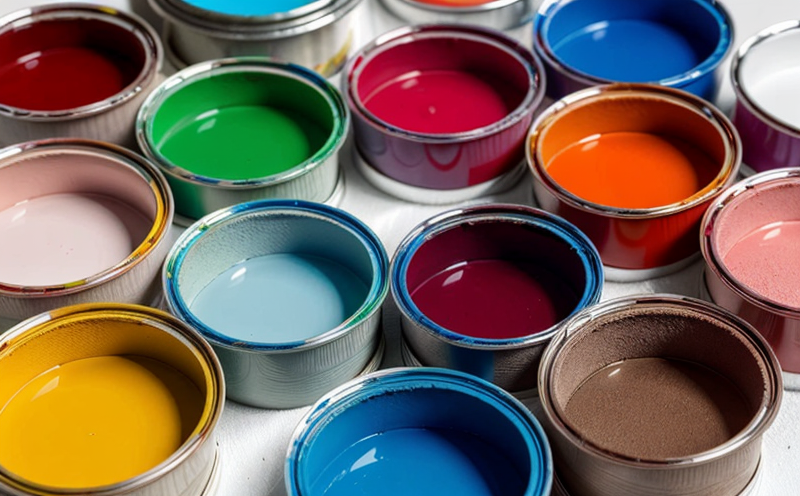ASTM F963 Solvent Residue in Painted Toys
The safety of toys is paramount to both manufacturers and consumers. ASTM F963-17, the standard consumer safety specification for toy safety, sets strict guidelines to ensure that toys are free from harmful substances which could pose a risk to children’s health. One critical aspect of this regulation involves ensuring that paints used in toy manufacturing do not contain excessive levels of solvent residues.
The ASTM F963 Solvent Residue in Painted Toys test is designed to measure the amount of volatile organic compounds (VOCs) and other solvents present in paint finishes applied to toys. This test is crucial for ensuring that paints used in toy manufacturing comply with safety standards, particularly concerning children's health and well-being.
During this testing process, a sample of the painted toy surface is subjected to extraction using a solvent similar to those used by children while playing or handling the toy. The extracted solvents are then analyzed for their total content. Excessive levels of these residues can be hazardous if ingested or inhaled and may lead to adverse health effects.
For accurate testing, proper sample preparation is essential. This involves selecting representative samples that reflect the typical paint application on the toy surface. The samples need to be cleaned and prepared according to ASTM F963-17 guidelines to ensure consistent results. Once prepared, they undergo extraction using a solvent, followed by quantification of the extracted solvents.
Testing laboratories must employ precision instruments capable of detecting even trace amounts of solvents. Modern analytical techniques such as gas chromatography-mass spectrometry (GCMS) are preferred for their accuracy and reliability in identifying and quantifying various organic compounds present in the extracts.
The results from this testing provide critical information regarding the compliance status of toys with ASTM F963-17 requirements. Compliance ensures that toys meet regulatory standards, protecting children from potential health risks associated with excessive solvent residues.
Understanding the importance of this test and its role in safeguarding child safety is crucial for toy manufacturers and quality managers. By adhering to these testing protocols, companies can ensure that their products not only meet but exceed international safety regulations.
- Regulatory Compliance: Ensures compliance with ASTM F963-17 standards.
- Health Protection: Protects children from potential health risks due to excessive solvent residues.
- Precision Instruments: Utilizes advanced analytical techniques like GCMS for accurate results.
Adhering strictly to these testing protocols is essential, as any deviation can lead to incorrect results and potentially non-compliant products. Therefore, it is vital that laboratories performing this test have the necessary expertise and equipment to ensure reliable outcomes.
In conclusion, ASTM F963 Solvent Residue in Painted Toys testing plays a crucial role in maintaining high standards of toy safety. By ensuring compliance with these stringent regulations, manufacturers can contribute significantly towards safeguarding children's health and well-being.
Benefits
The ASTM F963 Solvent Residue in Painted Toys test offers numerous advantages to toy manufacturers, regulatory bodies, and consumers. The primary benefit lies in the enhanced safety of toys for children, ensuring that they are free from harmful solvents that could pose risks if ingested or inhaled.
For manufacturers, this testing process ensures compliance with international standards, thereby avoiding potential legal issues and penalties associated with non-compliance. It also enhances brand reputation by demonstrating a commitment to product safety and quality.
From the perspective of regulatory bodies, such tests facilitate the enforcement of toy safety regulations, contributing to the broader goal of protecting public health. Compliance data from these tests can be used to monitor trends in toy safety and inform policy decisions.
Consumers benefit greatly by having access to safer toys that meet strict safety standards. This fosters trust between consumers and manufacturers, encouraging repeat purchases and positive brand loyalty.
In summary, ASTM F963 Solvent Residue in Painted Toys testing is a vital component of the toy manufacturing process, providing multiple layers of protection against potential hazards while promoting transparency and reliability.
Industry Applications
The ASTM F963 Solvent Residue in Painted Toys test has wide-ranging applications across various sectors within the toy industry. It is particularly relevant for manufacturers specializing in:
- Painted toys aimed at young children.
- Toys that come into direct contact with skin or are likely to be ingested by children.
- Outdoor play equipment and accessories where prolonged exposure to environmental factors may affect paint durability.
This test is essential for ensuring that paints used in these applications do not contain harmful levels of solvents, thereby safeguarding the health and well-being of children who use or interact with such toys. Compliance with ASTM F963-17 standards is a crucial step towards achieving this goal.
Use Cases and Application Examples
The ASTM F963 Solvent Residue in Painted Toys test finds application in several real-world scenarios. Here are some examples:
- New Product Development: Ensures that newly developed painted toys meet the stringent safety standards set by ASTM F963-17.
- Quality Assurance: Regularly conducted to verify ongoing compliance with international toy safety regulations.
- Supply Chain Management: Used to assess the reliability and consistency of paints supplied by external vendors.
- Customer Satisfaction: Demonstrates a commitment to product quality, enhancing customer trust and satisfaction.
In each case, this test serves as a critical tool in maintaining high standards of toy safety. Its application ensures that toys are not only functional but also safe for children's use.





